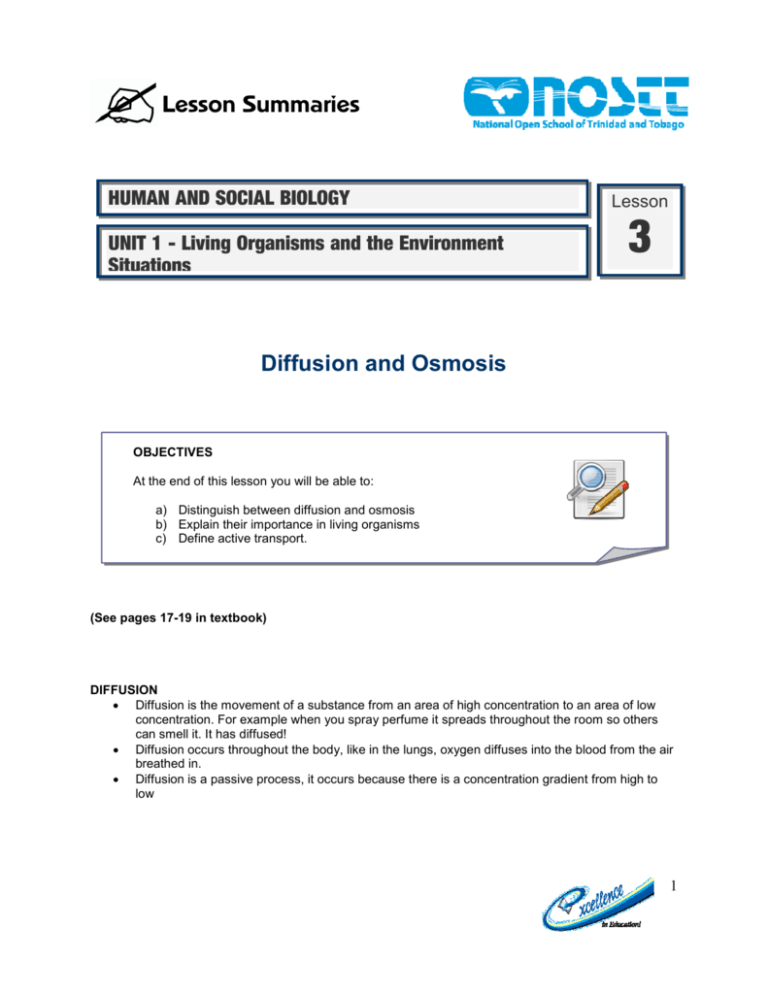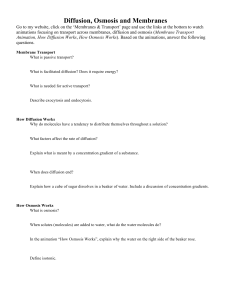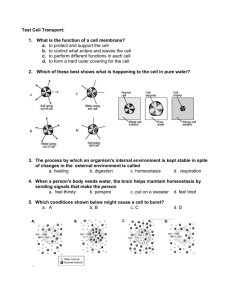Lesson Summaries Diffusion and Osmosis
advertisement

Lesson Summaries HUMAN AND SOCIAL BIOLOGY UNIT 1 - Living Organisms and the Environment Situations Lesson 3 Diffusion and Osmosis OBJECTIVES At the end of this lesson you will be able to: a) Distinguish between diffusion and osmosis b) Explain their importance in living organisms c) Define active transport. (See pages 17-19 in textbook) DIFFUSION • Diffusion is the movement of a substance from an area of high concentration to an area of low concentration. For example when you spray perfume it spreads throughout the room so others can smell it. It has diffused! • Diffusion occurs throughout the body, like in the lungs, oxygen diffuses into the blood from the air breathed in. • Diffusion is a passive process, it occurs because there is a concentration gradient from high to low 1 Study the diagram of the diffusion of a solute. OSMOSIS • Osmosis is a special type of diffusion • It occurs when water molecules move across a partially permeable membrane, like that of the cell membrane, from a dilute solution to a concentrated solution. • The solute particles are too large to pass through the membrane so only the water moves. Study the diagram of osmosis. 2 • • The solute particles cannot pass through the membrane holes. The water particles can pass through however so they move to equalize the concentration. Osmosis occurs in the kidneys of humans and in the roots of plants. THE IMPORTANCE OF DIFFUSION AND OSMOSIS • Diffusion is essential for many organisms as it is a feature of a number of processes which control and supply vital substances to the body in order for basic survival. A few of these are discussed below. Gas exchange is one of these processes. It is when much needed oxygen is obtained by the body in order for respiration to take place and the waste CO2 is taken out of the body. In us mammals, the exchange takes place in the lungs which contain a large number of alveoli. • The importance of osmosis is to keep equilibrium between the outside and inside environment. for example, from the soil to the root hairs of the plant for the osmosis of water. Soil has more concentration of water therefore it moves from soil to a region of low concentration (ie. Plant). ACTIVE TRANSPORT • Active transport usually happens across the cell membrane. There are thousands of proteins embedded in the cell's lipid bilayer. Those proteins do much of the work in active transport. They are positioned to cross the membrane so one part is on the inside of the cell and one part is on the outside. Only when they cross the bilayer are they able to move molecules and ions in and out of the cell. The membrane proteins are very specific. One protein that moves glucose will not move calcium (Ca) ions. There are hundreds of types of these membrane proteins in the many cells of your body. • Many times, proteins have to work against a concentration gradient. That term means they are pumping something (usually ions) from areas of lower to higher concentration. This happens a lot in neurons. The membrane proteins are constantly pumping ions in and out to get the membrane of the neuron ready to transmit electrical impulses. Diagram showing active transport 3 ASSESSMENT Diffusion & Osmosis Sample Test Questions 1. Please answer the following questions regarding if a red blood corpuscle were placed in sea water. I. Where is the greatest concentration of water? a.inside the cell b.outside the cell c.equal inside and outside the cell II.Which way is water moving? a.more into than out b.more out than in c.water is not moving d.both directions in equal amounts III. The content of the cell is______ to the outside environment. a.hypotonic b.isotonic c.hypertonic 2. An artificial cell can be made with a short length of dialysis tubing filled with liquid and clamped on each end. Answer the following question about an artificial cell and fill it with 80% sucrose solution, then place it in a beaker of 40% sucrose solution. I. The effect the movement of water will have on the size of this cell: a.no change b.cell gets bigger c.cell gets smaller II.The solution surrounding the cell is ___ to the inside of the cell. a.hypotonic b.hypertonic c.isotonic 3. What will happen to an onion cell in a hypotonic environment? a.fills up with water b.It puckers up c.plasmolysis d.cell ruptures 4. What would happen to a slug if salt is sprinkled on it? Why? 4








